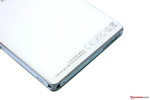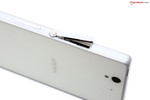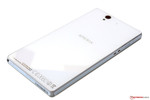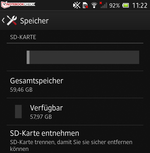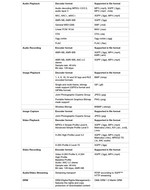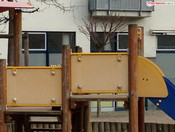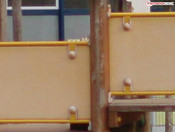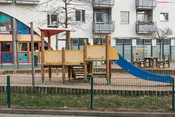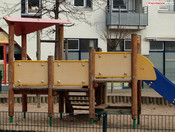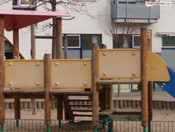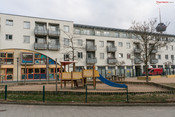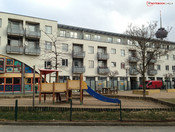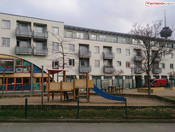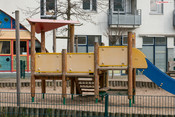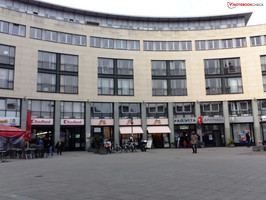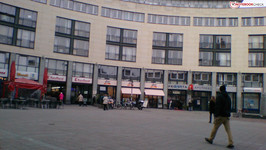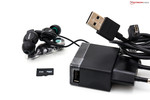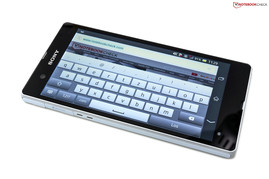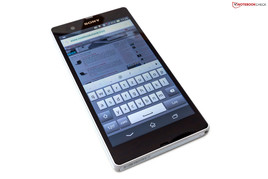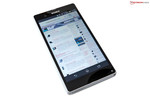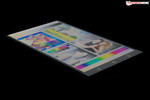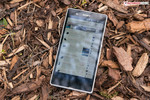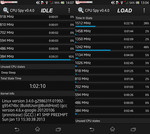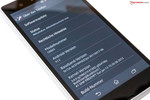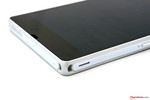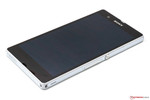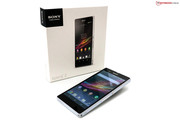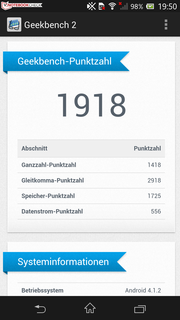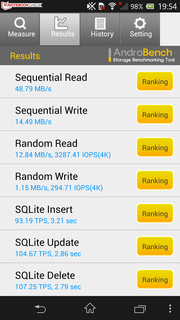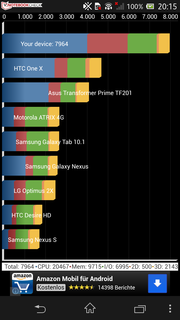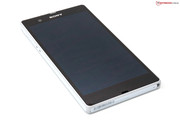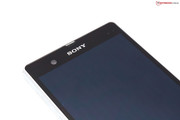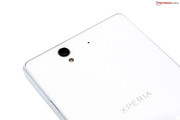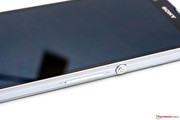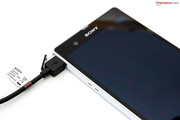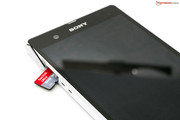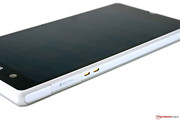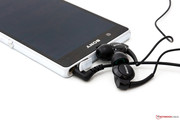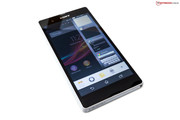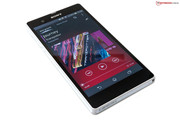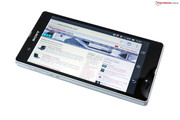回顾索尼XperiaŽ智能手机

For the original German review, see here.
The Japanese company Sony introduced the new high-end smartphone Xperia Z during the Consumer Electronics Show 2013 (CES). The new phone - which definitely raises the bar for smartphones - is now available in various countries. The competition doesn't sleep, however: the release of the HTC One (MZ) is right around the corner and we expect Samsung to introduce the Galaxy S4 in New York on March 14th.
What do all those phones have in common? The answer: a high-resolution TFT display with 1920x1080 pixels and 443 ppi. The 5-inch Sony Xperia Z is at the upper end as far as screen size is concerned: larger devices like it are usually called "phablets" - a combination of phone and tablet. Back to our review model: the Xperia Z is powered by a 1.5 GHz Quad-Core SoC (System-on-a-Chip), an integrated Qualcomm Adreno 320 GPU, 2 GB of RAM, and 16 GB flash storage. A card reader for MicroSD cards and LTE wireless complete the package.
Google Android 4.1.2 Jelly Bean is the current version of the mobile operating system. The phone, which is available in black, white, or purple, is available for 649 Euros (MSRP) / ~$845. Is our white review sample all show and no substance?
对于的德国原装审查,在这里看到。
日本索尼公司在消费电子展2013(CES)上推出了新的高端智能手机XperiaŽ的。新的手机 - 这无疑提高了酒吧的智能手机 - 现在可以在各个国家。本次大赛不睡觉,但是发布的HTC(MZ)对周围的角落,我们希望三星推出的Galaxy S43月14日在纽约。
所有这些手机有什么共同点呢?答案是:高清晰度的TFT显示屏,1920×1080像素,443 ppi的。 5英寸的索尼Xperia Z是尽可能的上端屏幕大小有关:喜欢它的大型设备通常被称为的“phablets” - 手机和平板电脑的组合。回到我们的评价模型的Xperia Z是采用1.5 GHz的四核的SoC(系统单晶片),集成高通Adreno320的GPU,2 GB的RAM,16 GB闪存存储。 A卡读卡器MicroSD卡和LTE无线完成封装。
谷歌Android4.1.2果冻豆是当前版本的手机操作系统。手机,这是黑色,白色或紫色,可为649欧元(MSRP)/〜845美元的。我们的白色审查样品是所有的表演并没有物质?
Case
Unpacking the phone reveals how large, but nonetheless extremely slim it is. Sony uses the term "OmniBalance" to describe this particular design, which is focused on "creating balance and symmetry" and features subtly rounded edges. The white model uses a plastic frame with small inlays. The front and the back are made of tempered glass. The phone ships with barely noticeable protective films applied to the front and back, which should not be removed. Applying a matte screen protector on top of the film doesn't pose any problems.
One distinguishing factor (unique selling proposition or USP) are the IP certifications - worldwide standards, which classify how well a device is protected against solid objects, dust, and water. The Sony Xperia Z complies with IP55 and IP57. The first number (5) indicates the protection against dust, the second indicates how the device handles mild jets (5) and immersion in water (7). Sony states that the Xperia Z can handle submersion for up to 30 minutes without any issues.
The build quality is impressive and the phone appears to be very durable. Even though the surfaces are smooth, they are easy to grip - although gloves or slightly damp fingers should be avoided. When twisting the phone, we didn't notice any creaking sounds, although the display does show some evidence of wave patterns, which also happen when localized pressure is applied to the screen area. The ports are protected with little covers - a feature which accentuates the sleek look of the phone. Because of it, the ports are also protected against dirt, although having to remove the covers can get a little tiresome over time. For those of you who don't like white: Sony also offers the Xperia Z in black and purple for the same price.
Let's look at the dimensions: the smartphone measures 71 x 139 x 7.9 millimeters (5.47 x 2.79 x 0.31 inches) and weighs in at 146 grams / 5.15 oz - fairly large, but not overly so. The Samsung Galaxy S3 measures 71 x 137 x 8.6 millimeters (5.47 x 5.39 x 0.34 inches) and weighs 133 grams / 4.69 ounces. The Google Nexus 4 (139 grams / 4.90 ounces) and the Asus PadFone 2 (135 grams / 4.76 ounces) are also quite comparable. Sony did good work here and managed to put a large display into a fairly compact and lightweight case.
拆开手机,发现它是多么大,但仍然非常渺茫。索尼采用术语“OmniBalance”来形容这种特殊的设计,这是专注于“创造平衡和对称”,并设有巧妙地圆边。白色机型采用塑料框与小嵌。钢化玻璃制成的正面和背面。电话一般几乎没有明显的保护膜的正面和背面,这不应该被删除。应用了磨砂屏幕保护膜上不构成任何问题。
一个显着的因素(独特的销售主张USP)是IP认证 - 全球标准,分类如何以及设备保护,防止固体物体,灰尘和水。索尼XperiaŽ符合IP55和IP57。第一个数字(5)表示的保护,防止灰尘,所述第二显示设备如何处理轻度射流(5)浸泡在水(7)。索尼的Xperia Z可以处理淹没长达30分钟没有任何问题。
构建质量是令人印象深刻的手机似乎是非常耐用。即使该表面是平滑的,它们很容易抓握 - ,虽然手套或略微潮湿的手指,应避免。扭曲的手机时,我们没有注意到任何吱吱作响的声音,虽然显示一些证据显示波图案,这也发生局部压力时,被应用到屏幕面积。端口保护小盖 - 一种特性,它的手机圆滑的外观展露无遗。因为它的端口也防止污垢,虽然有打开盖板可以随着时间的推移变得有点令人厌倦。对于那些你不喜欢白色的人:索尼还提供了Xperia Z在黑色和紫色以同样的价格。
让我们来看看智能手机测量尺寸:71 X 139毫米×7.9毫米(5.47所述2.79所述0.31英寸),重量为146克/ 5.15盎司 - 相当大的,但不能过于。三星Galaxy S3措施71 X 137 X 8.6毫米(5.47 X 5.39 X0.34英寸),重量为133克/ 4.69盎司。谷歌Nexus 4(139克/ 4.90盎司)和华硕PadFone 2(135克/ 4.76盎司)也相当类似。索尼在这里做了很好的工作,并成为一个相当紧凑,重量轻的情况下,设法把一个大型显示屏。
Connectivity
Sony doesn't offer the Xperia Z with different storage capacities - rather, the company chose to supplement the 16 GB of integrated flash storage with a MicroSD card reader supporting up to 64 GB (Sony includes a 2 GB card in the box). The usable capacity of the integrated flash - after the initial configuration - is 11.8 GB (about 74%).
The phone also offers a Micro-USB port which allows video output via MHL (Mobile High-Definition Link). The necessary adapter is not included and needs to be purchased separately. Next to the USB port, we find the card reader and the contact points for the optional docking station. Headsets can be connected using the 3.5 millimeter headphone jack, which is located on the top of the phone. The Xperia Z supports Micro SIM cards; Nano SIMs (Apple iPhone 5) can be used with an adapter.
索尼不提供具有不同存储容量的的Xperia Z - 相反,该公司选择了以补充集成的闪存存储16 GB的MicroSD卡读卡器支持多达64 GB(索尼在框中包括一个2 GB卡)。 - 在初始配置之后 - 集成闪存的可用容量为11.8 GB(约74%)。
该手机还提供了一个Micro-USB视频输出端口,允许通过MHL(移动高清连接)。必要的适配器不包括在内,需要单独购买。到USB端口的旁边,我们找到了读卡器和可选的基座的接触点。可以连接耳机使用的3.5毫米耳机插孔,它位于手机顶部。的的Xperia Z支持Micro SIM卡,苹果iPhone 5)纳米SIM卡(可以使用一个适配器。
Software
The Xperia Z ships with Google Android 4.1.2 (Jelly Bean) - the most current version of the Android operating system. Sony didn't modify the standard interface much. We do like the widgets, which can be accessed using the menu of the active applications (right Android button) and positioned freely.
We also like the customized system settings, but wish Sony would have omitted the bloatware - at least said software can be uninstalled easily. The overall performance of the OS is great: apps load quickly and delays are never an issue.
软件
谷歌Android4.1.2(果冻豆) - 最新版本的Android操作系统的XperiaŽ附带。索尼没有修改标准接口了。我们做类似的widget,可接使用菜单的活跃应用程序的Android按钮(右)和自由定位。
我们也很喜欢定制的系统设置,但希望索尼会省略了英国媒体报道的 - 至少说,软件可以很容易地卸载。的整体表现是伟大的操作系统,应用程序加载速度够快和拖延从来没有一个问题。
Communication & GPS
The communication options reflect the upscale positioning of the smartphone. Wireless connectivity supports WLAN standards 802.11b/g/n. For connection with (and too) other devices, Bluetooth 4.0 (A2DP) and NFC (Near Field Communication) are available.
Mobile internet access nowadays usually utilizes UMTS/HSPA+ technologies, which allows for speeds of up to 42 Mbit/s. The Xperia Z supports 850, 900, 1900, and 2100 MHz. Of course the smartphone also supports LTE (Long Term Evolution). In Germany, LTE uses 800, 1800, and 2600 MHz. The additional costs for LTE are unfortunately still comparatively high and - at least in Germany - the carriers require a contract.
Applications that require location data can access two different technologies: Assisted-GPS (A-GPS), which uses the American satellite network, and Glonass from the Russian Department of Defense. When we checked the quality of the GPS systems using GPS Test, we had no issues with the performance: the location was acquired within a few seconds and the position established accurately.
Telephony
The phone application is intuitive and neatly arranged. Contacts, favorites, and groups are located next to the dial pad - experienced Android-users as well as complete newbies won't have any problems finding their way around. Since the Xperia Z supports all four major GSM frequencies (850, 900, 1800, & 1900 MHz), the phone can be used in most countries.
通信与GPS
的通信选项体现高档定位的智能手机。无线连接支持支持802.11b/g/n无线局域网标准。 (太)等设备,蓝牙4.0(A2DP)和NFC(近场通信)的连接。
移动互联网接入,现在通常采用UMTS/ HSPA+技术,它允许高达42 Mbit / s的速度。的的Xperia Z支持850,900,1900,和2100 MHz。当然,智能手机还支持LTE(Long Term Evolution,长期演进)。在德国,LTE采用800,1800和2600兆赫。不幸的是LTE的额外费用还是比较高 - 至少在德国 - 运营商需要一个合同。
需要位置数据的应用程序可以访问:辅助型GPS(A-GPS),采用美国的卫星网络,俄罗斯国防部和GLONASS两种不同的技术。当我们检查质量的GPS系统,利用GPS测试,我们没有遇到任何问题的表现:位置在几秒钟内获得准确的位置建立。
电话
手机应用程序是直观,整齐地排列。联系人,收藏夹和组拨号盘毗邻 - 经验丰富的Android用户以及完整的新手,不会有任何问题,找到自己的方式解决。自的的Xperia Z支持所有四个主要的GSM频率(850,900,1800,1900兆赫),手机可以在大多数国家使用。
Cameras & Multimedia
The Sony Xperia Z offers two cameras. The main camera is on the back, offers 13 megapixels, and can take pictures with 4128x3096 pixels (4:3 aspect ratio) or 1080p (1920x1080 pixels). Photos with a large aspect ratio can be taken at 3920x2204 pixels (9 megapixels). The performance of the camera is OK when compared with the Apple iPhone 5 and our reference camera (Sony NEX-5). The comparison also shows that megapixels aren't everything: the camera of the Apple iPhone 5 produces the same picture quality, even though it features a lower resolution.
The 16x digital zoom should be avoided, since the quality decreases significantly even at the lower end of the digital range. The NEX-5R with its optical zoom clearly shows the difference. HTC seems to be going a different route now: the recently introduced One (codename M7) only features 4 megapixels, although the "Ultra-Pixel" technology is supposed to produce high quality photos despite the lower resolution.
索尼XperiaŽ提供了两个摄像头。背面的主摄像头,提供了13万像素,可拍照4128x3096像素(4:3宽高比)或1080P(1920×1080像素)。用大宽高比的照片,可拍摄3920x2204像素(10万像素)。相机性能是确定的,相比,苹果iPhone5和我们的参考相机(索尼NEX-5)。比较还显示,百万像素是不是一切:苹果iPhone5的摄像头产生同样的画面质量,即使它具有较低的分辨率。
应避免的16倍的数字变焦,由于质量显着降低,即使在数字范围的下端。 NEX-5R,其光学变焦清楚地显示了其中的差别。 HTC似乎是想现在不同的路线:最近推出的(代号M7)只设有4百万像素,虽然“超像素”技术应该是生产出高品质的照片,尽管分辨率较低。
The front camera of the Xperia Z is suitable for video conferencing and simple self portraits. The resolution is 2 megapixels; photos and videos can be recorded at FullHD resolution (1080p - 1920x1080 pixels). The quality compares well to the iPhone 5 - although the pictures are still not very sharp and show visible noise.
The smartphone supports all current audio and video formats. Matroska Media Container (.mkv) is frequently used for high-resolution videos and plays without any stutters or lags. The lossless audio compression format .flac is also supported via the preinstalled Walkman application.
前置摄像头的的Xperia Z是适合于视频会议和简单的自画像。该决议是2百万像素的照片和视频可以记录FullHD的分辨率(1080 - 1920×1080像素)。质量比较良好的iPhone 5 - 虽然图片不是很尖锐,并显示明显的噪音。
智能手机支持目前所有的音频和视频格式。媒体容器的Matroska(MKV)经常用于高清晰度视频和戏剧没有任何口吃或滞后。通过预装的随身听应用程序还支持无损音频压缩格式。后手。
Accessories
The accessories Sony includes don't quite reflect the premium standard of the phone. Aside from the phone itself, the modular USB power adapter, a cable, and documentation, Sony includes a MicroSD card with 2 GB capacity and an in-ear headset. The headset - which is pretty decent quality - and the small SD card are welcome items.
The charging dock DK26, which could be seen during the unboxing of the Japanese version of the Xperia Z, is also included in Germany - our review model shipped without it, however.
Warranty
In some countries, Sony offers a warranty of 24 months. Accessories and the integrated battery are covered for 12 months.
索尼配件包括不太反映的保费标准的手机。除了手机本身,模块化的USB电源适配器,电缆,和文档,包括索尼的MicroSD卡容量为2 GB和入耳式耳机。耳机 - 这是相当不错的品质 - 小的SD卡欢迎的项目。
充电底座,DK26,可以看出,在日文版的的Xperia Z拆箱,还包括在德国 - 没有它,我们的评价模型运,但是。
保
在一些国家,索尼还提供24个月的保修。包括配件和集成电池12个月。
Input Devices & Operation
For text input, the phone offers a virtual keyboard, which pops up automatically. The layout is generous and intuitive. Since there are several Android-specific elements on the bottom of the screen, the keyboard is moved up by a bit when in portrait mode. We like the additional row at the top, which includes many frequently needed special characters and thus makes typing easier.
Users who need to type a lot can do so in landscape mode. The virtual keyboard now starts at the lower border of the screen, although much of the content is not visible any longer. When using Whatsapp and similar applications, it's better to use the phone in portrait mode.
The capacitive touchscreen works very well. Up to 10 fingers can be recognized and multi-touch gestures are executed quickly and accurately. We didn't like the position of the rocker switch for the volume control - it is located too far down, in the same place where we would expect the power button. We would also have liked for Sony to include a dedicated button to open the camera application.
对于文本输入,手机提供了一个虚拟的键盘,它会自动弹出。布局是大方和直观。由于存在多种屏幕底部的机器人上的特定元素,键盘是由一个位时,在纵向模式下移动。我们喜欢额外的排在上面,其中包括许多经常需要的特殊字符,从而使打字变得更容易。
在横向模式下,用户需要键入了很多的人可以这样做。现在的虚拟键盘在屏幕的下边框,开始虽然大部分的内容是不可见的任何更长的时间。当使用WhatsApp的和类似的应用程序,这是在肖像模式下更好地使用手机。
电容式触摸屏工作得很好。可以识别多达10个手指和多点触摸手势,快速和准确地执行。我们不喜欢的位置为音量控制摇臂开关 - ,它位于太远了,在同一个地方,在这里我们希望电源按钮。我们也很喜欢索尼包括一个专门的按钮来打开相机应用程序。
Display
One of the most noticeable features of the Xperia Z is the large "HD Reality Display". The 5-inch panel features a resolution of 1920x1080 pixels (Full HD, 1080p) and offers a pixel density of 443 ppi. The trend right now definitely favors larger displays with higher resolution and corresponding pixel density. The Taiwanese maker HTC has their HTC One, which has a marginally smaller 4.7-inch display. Previous high-end phones can't quite compare: the 4-inch Apple iPhone 5 only has a resolution of 1135x640 pixels (326 ppi) - lower than the 720p standard of 1280x720 pixels. The Google Nexus 4 also only offers 1280x768 pixels and features a 4.7-inch display (320 ppi).
Sony touts their use of the "Mobile Bravia Engine 2" to improve picture quality. This particular technology is supposed to increase the vividness of the TFT panel - something we can confirm: both contrast and color saturation are increased by quite a bit. We did notice one disadvantage: when quickly cycling through high-resolution images, the technology needs up to a second to catch up. Overall, our impression is quite positive: text and pictures are extremely sharp.
We used the Gossen Mavo-Monitor to check the display quality. The brightness is very high: we measured above 400 cd/m² in all areas and an average of 428 cd/m². Sony mentions 500 cd/m² in their specifications, which we could not confirm. The brightness distribution is 88% - good, but not great. The panel is darker on the bottom than on the top, which is fortunately not noticeable.
对的Xperia Z的最显着特征之一是大的“HD现实显示”。 5英寸面板,拥有分辨率为1920×1080像素(全高清,1080),并提供一个像素密度为443 ppi。现在的趋势肯定是有利于更大的显示屏具有更高的分辨率和相应的像素密度。台湾制造商宏达电的HTC One,其中有一个稍微较小的4.7英寸显示屏。以往高端手机不能完全比较:苹果iPhone 5的4英寸,分辨率为1135x640像素(326 ppi)的 - 低于标准的1280×720像素的720p。谷歌的Nexus4也只提供了1280×768像素,并配有4.7英寸的显示屏(320 ppi)的。
索尼宣称他们使用的“移动BRAVIA引擎2”,以提高图像质量。这种特殊的技术,应该是增加了生动的TFT面板 - 的东西,我们可以确认:对比度和色彩饱和度都增加了颇有几分。我们也注意到一个缺点:快速骑自行车时,通过高分辨率的图像,该技术需要一秒钟赶上。总的来说,我们的印象是相当正面的文字和图片是非常尖锐的。
我们使用的戈森MAVO监视器检查显示质量。亮度非常高:我们测得400坎德拉/平方米的所有领域,平均为428坎德拉/平方米以上。索尼提到500坎德拉/平方米,其规格,这是我们无法确认。亮度分布是88% - 好,但不是很大。面板暗幸运的是,没有明显的顶部,而不是底部。
| |||||||||||||||||||||||||
Brightness Distribution: 88 %
Center on Battery: 441 cd/m²
Contrast: 464:1 (Black: 0.95 cd/m²)
The other measurements are less convincing: the black level value of 0.95 cd/m² is way too high and results in grayish blacks. The contrast ratio of 464:1 is also far from outstanding. Especially for watching movies, we'd appreciate a saturated black and a high contrast ratio.
其他测量是那么令人信服:0.95坎德拉/平方米的黑色电平值太高和结果呈灰黑色。 464:1的对比度也谈不上优秀。尤其是看电影,我们会很感激饱和的黑色和高对比度。
Outdoors, the phone benefits from the high brightness of the display. Inside, the screen content is easy to decipher, as long as direct light sources are avoided. Direct sunlight or a lamp behind the user require that the brightness is set to maximum - in this case, the low contrast and the glare-type display cause some issues. The content is still easy to identify, even though reflections can't be avoided.
The viewing angles of the IPS LCD panel are also disappointing: even little deviations in the vertical plane cause a loss of brightness. Horizontally, things look better, although we could also observe a decrease in picture quality. We would have expected much better performance in this area.
户外高亮度显示屏,手机的好处。里面,屏幕内容很容易破解,只要避免直接光源。直射的阳光或灯后面的用户所需要的亮度设定为最大 - 在这种情况下,对低对比度和眩光型显示导致一些问题。内容仍然很容易识别,即使不能避免反射。
视角的IPS液晶面板也令人失望,甚至有点在垂直平面上的偏差导致的亮度损失。横向上,东西更好看,虽然我们也可以观察到的图像质量下降。我们本来期望在这方面表现更好。
In addition to the latest version of Google's OS, the Xperia Z also features powerful hardware. The smartphone is powered by the (slightly older) 1.5 GHz Qualcomm Snapdragon S4 Pro APQ8064A SoC, which utilizes four cores, and an integrated Adreno 320 GPU. We already looked at the hardware when we reviewed the Asus PadFone 2. The Mobile World Congress 2013 saw the introduction of a few smartphones featuring the new Snapdragon 600 SoC, which offers more performance, while being more frugal at the same time. The Xperia Z comes with 2 GB RAM and 16 GB integrated flash storage. Sony currently doesn't offer a model with 32 GB or 64 GB - but the card reader allows the user to increase the storage capacity.
We use several different system benchmarks to evaluate the various phones. Our review model achieved 14244 points running AnTuTu Benchmark (Version 3) - a bit lower than older high-end phones, like the Samsung Galaxy S3. The new HTC One X+ with Nvidia Tegra 3 SoC is 14% faster; the much cheaper Google Nexus 4, 23%. However, the Sony does well running NenaMark 2 and GeekBench 2 - the differences are now almost negligible.
Interesting are the results of Basemark ES 2.0: the Sony Xperia Z only manages 38.14 FPS - about half of the Asus PadFone 2, which features the same hardware. The Samsung Galaxy S3 does about as well as the Sony, the HTC One X+ falls behind and ends up in last place in our comparison (15.53 FPS).
For our last benchmark, we ran the Linpack multi-thread test. The Sony Xperia Z scored 570 MFLOPS - a very good result. The Asus PadFone 2 and the Apple iPhone 5 do as well, the Samsung Galaxy S3 ends up with only 137 MFLOPS (-76%).
除了谷歌的操作系统的最新版本的Xperia Z还拥有强大的硬件。智能手机是由年龄稍大的1.5 GHz的高通Snapdragon S4 Pro的APQ8064A的SoC,它采用四核,并且集成Adreno 320 GPU。我们已经看到在硬件,当我们回顾了华硕Padfone 2。移动世界大会2013看到几个智能手机的推出新的Snapdragon 600芯片,它提供了更高的性能,而同时更加节俭。的的Xperia Z配备了2 GB RAM和16 GB集成的闪存存储。索尼目前不提供32 GB或64 GB的模型 - 但卡阅读器允许用户增加存储容量。
我们使用几种不同的系统基准测试,以评估各种手机。我们的审查模式运行将AnTuTu基准测试(第3版)达到14244点 - 稍低于旧的高端手机,如三星Galaxy S3。新的HTC One X +与Nvidia的Tegra 3 SoC的是快14%,更便宜,23%的谷歌Nexus 4。但是,索尼并良好运行NenaMark 2软件Geekbench 2 - 的差异,现在几乎可以忽略不计。
有趣的是结果的Basemark ES 2.0:索尼XperiaŽ仅管理38.14的FPS - 约一半的华硕PadFone 2,它具有相同的硬件。三星Galaxy S3约以及索尼,HTC One X的落后,并最终在去年发生在我们的比较(15.53 FPS)。
对于我们的最后基准,我们跑在Linpack多线程测试。索尼XperiaŽ拿下了570 MFLOPS - 一个非常好的结果。华硕Padfone 2和苹果iPhone 5,三星Galaxy S3最终只有137 MFLOPS(-76%)。
| AnTuTu v3 - Total Score (sort by value) | |
| Sony Xperia Z | |
| Samsung Galaxy S3 | |
| HTC One X+ | |
| Google Nexus 4 | |
| NenaMark2 - --- (sort by value) | |
| Sony Xperia Z | |
| Samsung Galaxy S3 | |
| Asus Padfone 2 | |
| HTC One X+ | |
| Google Nexus 4 | |
| Geekbench 2 - 32 Bit - Total Score (sort by value) | |
| Sony Xperia Z | |
| Samsung Galaxy S3 | |
| Asus Padfone 2 | |
| HTC One X+ | |
| Google Nexus 4 | |
| Apple iPhone 5 | |
| Basemark ES 2.0 - Taiji Free (sort by value) | |
| Sony Xperia Z | |
| Samsung Galaxy S3 | |
| Asus Padfone 2 | |
| HTC One X+ | |
| Google Nexus 4 | |
| Linpack Android / IOS - Multi Thread (sort by value) | |
| Sony Xperia Z | |
| Samsung Galaxy S3 | |
| Asus Padfone 2 | |
| HTC One X+ | |
| Google Nexus 4 | |
| Apple iPhone 5 | |
Browser benchmark test allow us to compare smartphones with Android OS to phones with Windows Phone 8 (WP8). The Sony Xperia Z uses Google Chrome as the default browser. Running the fairly new Peacekeeper benchmark results in 388 points - faster than the Samsung ATIV S with WP8 (by about 16%), but slower than the Samsung Galaxy S3 (+ 71%), the HTC One X+ (+ 72%) or the iPhone 5. The smartphone from the manufacturer in Cupertino runs the mobile version of the Safari browser and scored 863 points (+ 122%).
The (frequently used) Browsermark 2.0 shows less of a difference: the result of 1773 points places the Sony Xperia Z right in the middle of the current crop of premium smartphones. The Asus PadFone 2 is quite a bit faster though and scores 2592 points (+ 46%). The additional tests Google's V8 and Sunspider 0.9.1 (a JavaScript benchmark) confirm that smartphones with Windows Phone 8 generally score less than phones with Google Android. The Apple iPhone 5 either scores fairly similar or higher than the Android-equipped competition.
除了谷歌的操作系统的最新版本的Xperia Z还拥有强大的硬件。智能手机是由年龄稍大的1.5 GHz的高通Snapdragon S4 Pro的APQ8064A的SoC,它采用四核,并且集成Adreno 320 GPU。我们已经看到在硬件,当我们回顾了华硕Padfone 2。移动世界大会2013看到几个智能手机的推出新的Snapdragon 600芯片,它提供了更高的性能,而同时更加节俭。的的Xperia Z配备了2 GB RAM和16 GB集成的闪存存储。索尼目前不提供32 GB或64 GB的模型 - 但卡阅读器允许用户增加存储容量。
我们使用几种不同的系统基准测试,以评估各种手机。我们的审查模式运行将AnTuTu基准测试(第3版)达到14244点 - 稍低于旧的高端手机,如三星Galaxy S3。新的HTC One X +与Nvidia的Tegra 3 SoC的是快14%,更便宜,23%的谷歌Nexus 4。但是,索尼并良好运行NenaMark 2软件Geekbench 2 - 的差异,现在几乎可以忽略不计。
有趣的是结果的Basemark ES 2.0:索尼XperiaŽ仅管理38.14的FPS - 约一半的华硕PadFone 2,它具有相同的硬件。三星Galaxy S3约以及索尼,HTC One X的落后,并最终在去年发生在我们的比较(15.53 FPS)。
对于我们的最后基准,我们跑在Linpack多线程测试。索尼XperiaŽ拿下了570 MFLOPS - 一个非常好的结果。华硕Padfone 2和苹果iPhone 5,三星Galaxy S3最终只有137 MFLOPS(-76%)。
| Peacekeeper - --- (sort by value) | |
| Sony Xperia Z | |
| Samsung Galaxy S3 | |
| Google Nexus 4 | |
| Apple iPhone 5 | |
| HTC One X+ | |
| Samsung ATIV S | |
| Browsermark - --- (sort by value) | |
| Sony Xperia Z | |
| Samsung Galaxy S3 | |
| Google Nexus 4 | |
| Apple iPhone 5 | |
| HTC One X+ | |
| Asus Padfone 2 | |
| Nokia Lumia 920 | |
| Samsung ATIV S | |
| Google V8 Ver. 7 - Google V8 Ver. 7 Score (sort by value) | |
| Sony Xperia Z | |
| Samsung Galaxy S3 | |
| Google Nexus 4 | |
| Apple iPhone 5 | |
| HTC One X+ | |
| Asus Padfone 2 | |
| Nokia Lumia 920 | |
| Samsung ATIV S | |
| Sunspider - 0.9.1 Total Score (sort by value) | |
| Sony Xperia Z | |
| Samsung Galaxy S3 | |
| Google Nexus 4 | |
| Apple iPhone 5 | |
| HTC One X+ | |
| Asus Padfone 2 | |
| Nokia Lumia 920 | |
| Samsung ATIV S | |
* ... smaller is better
The integrated flash storage leaves a favorable impression: AndroBench 3 attests a sequential read speed of about 49 MB/s. Only the Google Nexus 4 is a little bit faster here. The Xperia Z does better during sequential writes: up to 14.5 MB/s is possible. The 4KB tests are also convincing. Overall, the performance of the flash module indicates that it is of very high quality.
集成的闪存存储留下一个良好的印象:AndroBench3证明约49 MB / s的顺序读取速度。只有谷歌Nexus4是快一点点。没有更好的的Xperia Z在顺序写入:高达14.5 MB / s的可能。 4KB的测试也令人信服。总体而言,Flash模块的性能表明,这是非常高的质量。
| AndroBench 3-5 | |
| Random Write 4KB (sort by value) | |
| Sony Xperia Z | |
| Samsung Galaxy S3 | |
| Google Nexus 4 | |
| HTC One X+ | |
| Asus Padfone 2 | |
| Random Read 4KB (sort by value) | |
| Sony Xperia Z | |
| Samsung Galaxy S3 | |
| Google Nexus 4 | |
| HTC One X+ | |
| Asus Padfone 2 | |
| Sequential Write 256KB (sort by value) | |
| Sony Xperia Z | |
| Samsung Galaxy S3 | |
| Google Nexus 4 | |
| HTC One X+ | |
| Asus Padfone 2 | |
| Sequential Read 256KB (sort by value) | |
| Sony Xperia Z | |
| Samsung Galaxy S3 | |
| Google Nexus 4 | |
| HTC One X+ | |
| Asus Padfone 2 | |
Gaming
The integrated Qualcomm Adreno 320 GPU has no issues with gaming - even the more demanding 3D games from Google's Play Store work well. We downloaded ShadowGun: DeadZone and enjoyed the smooth performance on the 5-inch screen. A minor point of criticism: the right side of the screen loses some real estate because of the permanent Android buttons and the menu bar. All things considered though: smartphone-gaming is a lot of fun on this device. The high pixel density of 443 ppi certainly helps here - although the applications need to be optimized for HiDPI displays.
集成了高通Adreno320的GPU游戏没有问题 - 甚至更为苛刻的3D游戏,从谷歌播放商店工作。我们下载暗影之枪:盲区,并享受5英寸的屏幕上表现平稳。批评:一个小点在屏幕的右侧失去了一些房地产,因为永久的Android按钮和菜单栏。虽然所有的事情考虑:智能手机游戏是一个很大的乐趣在此设备上。高像素密度为443 ppi,这里有一定的帮助 - ,虽然应用需要优化为HIDPI显示。
Call quality
We used the Xperia Z for several phone calls and were left with a positive impression: neither we nor our call partners had any issues with the communication quality. The speaker phone - utilizing the mono speaker - also worked well. The sound in general is very natural; ambient noise (train, city, etc.) is filtered well.
我们使用的的Xperia Z几个电话,并留下了积极的印象:无论是我们还是我们的呼叫伙伴的通信质量有任何问题。 - 利用单声道扬声器 - 扬声器电话也运作良好。一般的声音是很自然的过滤环境噪声(火车,城市等)。
Temperature
The Sony Xperia Z runs fairly hot. During idle, the phone gets lukewarm to warm - we recorded up to 36.7 °C (98.06 °F). The back also gets noticeably warm and registers 35 °C (95 °F). A smartphone shouldn't really get warmer than 30 °C (86 °F) in this scenario. Although these measurements are a bit higher than expected, they are still acceptable for daily use.
Under load, temperatures increase as one would expect. After one hour of running a stress test (we use Stability Test), the phone gets quite warm - on the back especially in the upper half. The Asus PadFone 2 does well in this test during idle as well as load scenarios. The Apple iPhone 5 stays cool during idle; under load, it performs about as well as our review model and the Google Nexus 4 or the Samsung Galaxy S3.
索尼XperiaŽ运行相当热。在空闲时,手机变得不冷不热地暖 - 我们录得高达36.7°C(98.06°F)。背面也得到明显的温暖和寄存器35°C(95°F)。智能手机应该没有真正得到温度超过30°C(86°F),在这种情况下。虽然这些测量是有点高于预期,它们是日常使用还是可以接受的。
负载下,温度增加,正如人们所预料。经过一小时的运行压力测试(我们使用的稳定性测试),手机变得相当热情 - 尤其是在上半的背面。华硕Padfone2以及在本次测试期间以及闲置负载情况。苹果iPhone 5在空闲保持冷静;负载下,它执行以及我们的评价模型和谷歌Nexus4或三星Galaxy S3。
(±) The maximum temperature on the upper side is 44 °C / 111 F, compared to the average of 35.2 °C / 95 F, ranging from 21.9 to 247 °C for the class Smartphone.
(±) The bottom heats up to a maximum of 41.9 °C / 107 F, compared to the average of 34 °C / 93 F
(±) In idle usage, the average temperature for the upper side is 34.5 °C / 94 F, compared to the device average of 32.9 °C / 91 F.
Speaker
The Sony Xperia Z utilizes a mono speaker located on the right side of the phone towards the bottom. This position is less than ideal, since it's easy to cover the opening with the hand when holding the phone. The sound is surprisingly good - although bass and lows are lacking, both highs and mids are clear. We also did not notice any distortion even with the volume turned up all the way. The HTC One (M7) features two speakers above and below the screen and will probably be the new leader in this area.
A 3.5 millimeter headphone jack allows the connection of headsets or external speakers and offers very good output quality. Another way to hook up external speakers is with a Micro USB to HDMI MHL adapter. The included in-ear headset is also decent, albeit far from qualifying as a high-end accessory. Not everybody will appreciate the form factor, however.
索尼XperiaŽ采用了单声道扬声器位于底部将手机靠近右侧。这一立场是不太理想,因为它很容易与手拿着手机时,以覆盖开口。声音是出奇的好 - 虽然缺乏低音和低点,高点和中频清晰。我们也没有发现任何变形,甚至与量翻了所有的方式。 HTC(M7)功能,在屏幕的上方和下方的两个扬声器,并在这个领域可能将成为新的领导人。
一个3.5毫米耳机插孔可以连接耳机或外部扬声器,并提供了非常良好的输出质量。连接外部扬声器的另一种方法是有Micro USB HDMI MHL适配器。入耳式耳机是还过得去,虽然远离资格作为一个高端的配件。 ,但是并不是每个人都明白的形式因素。
Power Consumption
The power consumption is crucial for a decent battery life. In the case of the Xperia Z, the large display might influence the run times. Our review model consumed between 1.8 and 3.7 watts during idle - higher than average. The Apple iPhone 5 offers superior performance in this area and only consumes 0.4 watts (a difference of 78%). The maximum idle power consumption of the iPhone 5 and the Google Nexus 4 is 1.4 watts (a difference of 62%). The Asus PadFone 2 with the same SoC requires up to 1.9 watts (a difference of 49%).
Under load, the Xperia Z requires up to 6.6 watts. In this case, the difference is much less noticeable: the Google Nexus 4 uses up to 6.5 watts, the Asus PadFone 2 6.1 watts. The clear winners are the Apple iPhone 5 and the Samsung Galaxy S3, which require 2.9 and 3.4 watts respectively. A reason for the somewhat higher power requirements of the Xperia is most likely the larger screen coupled with a high average brightness.
The lithium-ion battery is unfortunately not removable and offers a capacity of 2330 mAh. Since the battery is not replaceable, it's advisable to always pack the included USB cable and charger.
功耗是一个体面的电池寿命至关重要。在大屏幕显示器的的Xperia Z的情况下,可能会影响到运行时间。我们的审查模式之间消耗1.8瓦和3.7瓦,闲置期间 - 高于平均水平。苹果iPhone 5在这方面提供了优越的性能,只消耗0.4瓦(相差78%)。的iPhone 5和谷歌Nexus4最大空闲功耗为1.4瓦(相差62%)。华硕的PadFone2具有相同的SoC要求1.9瓦(相差49%)。
负载情况下,需要的的Xperia Z到6.6瓦。在这种情况下,不同的是不太明显的:谷歌Nexus4使用到6.5瓦,华硕的PadFone2 6.1瓦。明显的赢家是苹果iPhone5和三星Galaxy S3,分别需要2.9和3.4瓦。稍高的电源要求的Xperia的一个原因很可能是更大的屏幕加上高平均亮度。
不幸的是,锂离子电池不可拆卸,并提供了一个容量为2330 mAh。由于电池不可更换,这是可取的总是包附带的USB线和充电器。
| Off / Standby | |
| Idle | |
| Load |
|
Key:
min: | |
Battery Life
Sony promises a talk time of up to 11 hours and a standby time (WLAN deactivated) of up to 550 hours. Of course, we also run our own tests to determine how the phone performs.
To determine the worst-case scenario, we use the tool Stability Test. For this test, we set the screen brightness to its maximum and enable Wi-Fi. The Sony lasted 2 hours and 23 minutes - not really that bad, considering that the Apple iPhone 5, Google Nexus 4, and the Asus PadFone 2 perform about the same. The Samsung Galaxy S3 pulled ahead and lasted for over four hours. To establish the maximum battery life, we turn the screen brightness all the way down and disable Wi-Fi. In this case, the Xperia Z kept going for 14 hours and 34 minutes before we needed to plug it back in. Google's Nexus 4 did not do as well and managed 12 hours, the Apple iPhone 5 outlasted its competition and kept going for 22 hours.
Our WLAN surf-test simulates a real life scenario. With the screen brightness set to 150 cd/m², a script visits different types of websites in 40 second intervals. Our review model managed 8 hours and 50 minutes before the battery was empty - a result similar to the competition with one notable exception: the Apple iPhone 5 ran for 15 hours and 20 minutes - albeit without any flash videos.
Of course reduced brightness settings are not always an option. We decided to run the aforementioned test with the screen set to maximum brightness: the result is a run time of 5 hours and 20 minutes. We kept the same settings and checked video playback using a Full HD video (1080p, .mkv). The phone shut down after exactly four hours - more than enough for a feature-length movie.
索尼承诺通话时间长达11小时,待机时间可达550小时(WLAN停用)。当然,我们也可以运行我们自己的测试,以确定手机如何执行。
要确定最坏的情况下,我们使用的工具的稳定性测试。在这个测试中,我们设置屏幕亮度调至最大,并启用Wi-Fi。索尼历时2小时23分钟 - 不是真的那么坏,考虑到苹果的iPhone5,谷歌Nexus4,华硕Padfone2的表现基本持平。三星Galaxy S3拉进取,持续4个多小时。要建立最大的电池寿命,我们将屏幕亮度一路下跌,并关闭Wi-Fi。在这种情况下,的的Xperia Z一直持续了14小时,34分钟之前,我们需要重新插上。谷歌的Nexus4没有做的一样好,管理12个小时,苹果iPhone5经久竞争和持续22小时。
我们的WLAN冲浪测试模拟真实的生活场景。随着屏幕亮度设置为150坎德拉/平方米,脚本访问不同类型的网站,在40秒的时间间隔。我们的审查模式管理8小时,前50分钟的电池是空的 - 有一个例外:苹果iPhone 515小时和20分钟跑了 - 虽然没有任何Flash视频的竞争相似的结果。
当然,降低亮度设置并不总是一个选项。我们决定设置到最大亮度的屏幕,运行上述测试结果是一个运行时间5小时20分钟。我们保持了相同的设置和检查使用全高清视频(1080,MKV)视频播放。手机关机后四个小时 - 足够多的长篇电影。
Verdict
The Sony Xperia Z does do many things right: we like the good looking design, the IP certifications, and the extremely sharp 5-inch Full HD display. The phone features many different connection options and its hardware offers good performance. The weakest area of this premium smartphone is its high-resolution display panel: the viewing angle stability is not great, the black level too high, and the contrast way too low. As far as the hardware and performance is concerned, we should take into consideration that the Sony Xperia Z is available now; the HTC One (M7) and Asus PadFone Infinity - both of which will be equipped with the new (and more powerful) Snapdragon 600 SoC - are not released yet.
The camera is good enough for simple snapshots - but in this case, less would have been more: megapixels aren't everything. We like the widgets in the multi-tasking menu of the Google Android 4.1.2 operating system - although they are not really important. The usability of the capacitive touchscreen is good and inputting text is easy. The phone gets a bit too warm during idle, the power consumption is comparatively high, and the battery life is only average. The position of the control elements and the speaker is also less than ideal.
We do know that some users will think that we are too critical - but considering the pretty steep price tag of 650 Euros (~$850), we really would expect a better-performing display. As it stands now, we don't think the Xperia Z is going to have an easy time taking on the competition.
索尼Xperia Z就做很多事情:我们喜欢好看的设计,IP认证,和极陡峭的5英寸全高清显示器。该手机配有许多不同的连接选项,它的硬件提供良好的性能。这个溢价智能手机最弱的地区是其高分辨率的显示面板:视角稳定性是不是很大,黑电平过高,过低的对比度方式。至于硬件和性能而言,我们应该考虑到,索尼Xperia Z是现在的HTC(M7),华硕PadFone的无穷 - 这两者都将配备新的(更强大的)的Snapdragon 600 SOC - 尚未发布。
该相机是不够好,简单的快照 - 但在这种情况下,更不会有更多的百万像素是不是一切。我们喜欢的widget多任务菜单中的谷歌Android4.1.2操作系统 - 虽然他们是不是真的很重要。电容式触摸屏的可用性是好的,输入文字是很容易的。手机变得有点太热情在空闲,功耗比较高,电池的寿命是只有平均水平。控制元件和扬声器的位置也不太理想。
我们知道,一些用户会认为我们太关键了 - 但考虑到相当陡峭的价码为650欧元(约$850),我们真的希望一个更好的表现显示。就目前,我们不认为的Xperia Z是有一个简单的时间上的竞争。




